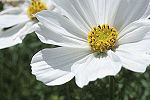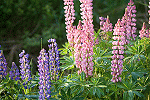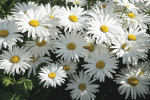The Governor's Lilac and Wildflower Commission
 |
Cosmos (Cosmos bipinnatus) Cosmos grows 2-3 feet tall and is branched several times in the upper half with a single flower head about 1 1/4 inches across at the end of each slender bare stem. It has 8 pale-orchid ray flowers with a yellow center. It is an attractive flower suitable for cultivation and seeds are commercially available. Leaves are threadlike divided 2 or 3 times. It is not abundant as it is grazed by livestock. Blooms quickly. Will need to be replanted each spring for continued success.
|
 |
Black Eyed Susan (Rudbeckia hirta L.) This prairie biennial forms a rosette of leaves the first year followed by flowers the second year. It is covered with hairs that give it a slightly rough texture. The Green-headed Coneflower (R. laciniata) has yellow ray flowers pointing downward a greenish-yellow disk and irregularly divided leaves. May bloom longer with some afternoon shade. Birds enjoy the ripe seeds. Black-eyed Susan can become aggressive if given too perfect an environment and not enough competition.
|
 |
Wild Lupine (Lupinus perennis L.) Showy elongate clusters of purple pea-like flowers top the 1-2 ft. stems of this perennial lupine. Blue pea-like flowers are in an upright elongated terminal cluster on an erect stem with palmately compound leaves. Its leaves are palmately divided into 7-11 leaflets. Occasionally flowers range from pink to white. The plant was once thought to deplete or wolf the mineral content of the soil; hence the genus name derived from the Latin lupus (wolf). Actually the plant and all the family enhances soil fertility by fixing atmospheric nitrogen into a useful form. In the south this flower has narrower leaflets and is often recognized as a separate species Nuttals Lupine (L. nuttallii). Two southern species with undivided elliptic leaves are Spreading Lupine (L. diffusa) with blue flowers and a whitish spot on the standard (upper petal) and Hairy Lupine (L. villosus) a hairy plant with lavender-blue flowers and a red-purple spot on the standard. They are found from North Carolina to Florida and west to Louisiana. A species found in Nebraska Wyoming and Colorado Nebraska Lupine (L. plattensis) has blue flowers with a dark spot on the standard and paddle-shaped leaflets. L. polyphyllus is becoming extremely abundant in the Northeast particularly Maine and adjacent Canada; it was introduced from the Northwest.
|
 |
Shasta Daisy (Chrysanthemum maximum) A hardy perennial, forming dense colonies once established. Native to Europe, it has naturalized throughout all regions of the United States. The white petalled flowers with golden yellow centers are borne individually on single erect stems. Compared to its cousin, the Ox-Eyed Daisy, Shasta Daisies generally grow 6 to 12 inches taller and have a larger flower head diameter. Prefers full sun to partial shade in fertile soil. Shasta Daisy is excellent as a ground cover or border plant since the foliage is attractive and remains green all year. They are also an ideal cut flower, lasting up to 10 days in arrangements.
|
next: Planting...
